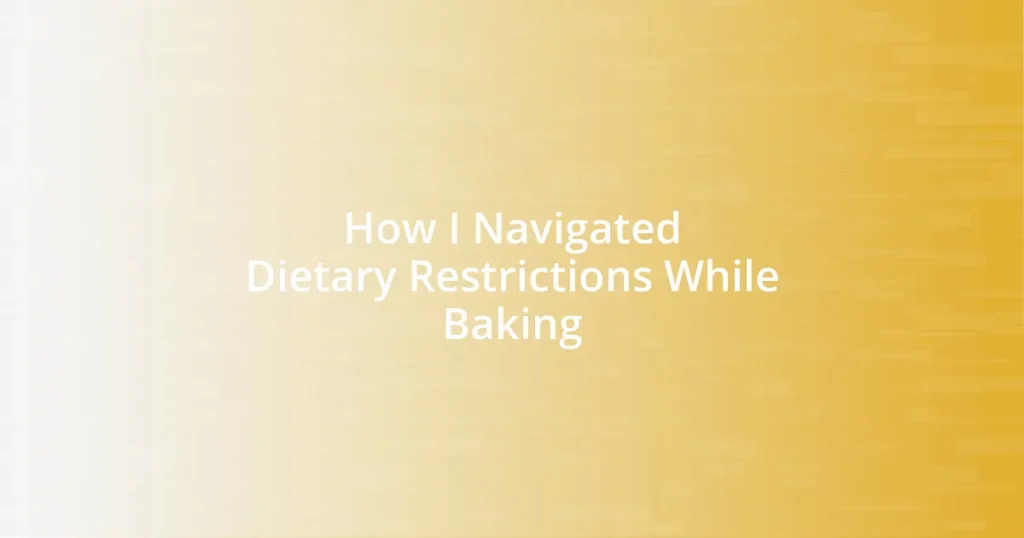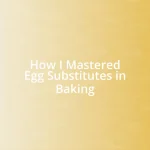Key takeaways:
- Understanding dietary restrictions enhances empathy and fosters inclusivity in baking, allowing everyone to enjoy treats together.
- Common baking restrictions include gluten intolerance, lactose intolerance, nut allergies, egg allergies, and veganism, each requiring thoughtful ingredient substitutions.
- Experimenting with alternative ingredients like different flours and sweeteners can transform recipes while accommodating dietary needs.
- Documenting baking experiments helps track successes and failures, creating a personal reference for refining techniques in future baking endeavors.
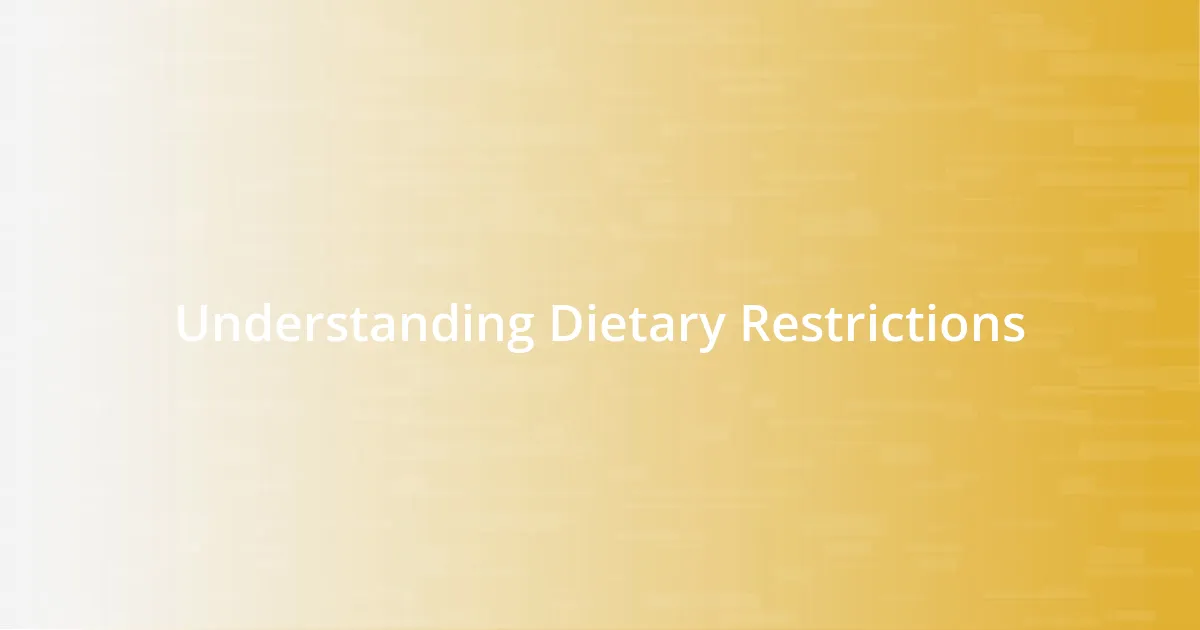
Understanding Dietary Restrictions
Dietary restrictions can feel overwhelming, especially when they touch on personal health and well-being. I remember when a close friend revealed her gluten intolerance; it hit me hard because I loved sharing baked goods with her. How could I create something delicious without my usual flour base? This moment sparked my journey into understanding how food can impact someone’s life beyond just taste.
Navigating these restrictions often requires empathy and a willingness to experiment. When I started baking for others with diverse needs, it felt like being a chef on a mission. I discovered the power of alternative ingredients, such as almond flour or coconut sugar, and the joy these swaps brought to those who felt excluded from enjoying treats. Have you ever considered how those with dietary limitations might feel, watching while others indulge? It opened my eyes to the necessity of inclusivity in baking.
Every edible creation becomes a bridge for connection. I’ve seen firsthand how accommodating a friend’s nut allergy led to an unforgettable evening of laughter and shared experiences. It’s in these moments that you truly realize the role food plays in our social lives. Understanding dietary restrictions isn’t just about ingredients—it’s about fostering relationships and making everyone feel welcome at the table.

Identifying Common Baking Restrictions
When diving into the world of baking with dietary restrictions, I often find myself identifying which ones are the most common among my friends and family. It’s not just about the ingredients; it’s about recognizing the emotional weight these restrictions carry. I remember the first time I baked for a childhood friend who had to cut out dairy. It felt like a delicate balance—I was excited to create something special, but also apprehensive about making sure it was truly enjoyable for her.
Here’s a list of common baking restrictions I’ve encountered:
- Gluten Intolerance/Celiac Disease: Affects those who cannot consume wheat, barley, or rye.
- Lactose Intolerance/Dairy Allergy: Individuals who struggle with dairy or have allergies often feel left out.
- Nut Allergies: For someone with nut allergies, even the smallest exposure can trigger a severe reaction.
- Egg Allergies: Many bakers need to find egg substitutes to accommodate others.
- Veganism: This lifestyle excludes all animal products, requiring creativity in ingredient substitutions.
Understanding these restrictions can feel like a puzzle where the pieces don’t always fit, yet I relish the challenge. It’s a wonderful exercise in innovation and compassion when I see the smiles on my friends’ faces, realizing they can join in on the festivities too.

Substituting Ingredients for Allergies
Substituting ingredients for allergies can initially seem daunting. I vividly remember the first time I baked for my cousin with a severe tree nut allergy. The anxiety in choosing the right ingredients was palpable—I had to scrutinize every label, but it taught me the beauty of precaution. Instead of using almond flour, I turned to oat flour, which provided a wonderful texture without compromising on taste. Have you ever considered how much a simple swap can bring joy to someone who usually feels left out during dessert time?
It’s amazing how versatile ingredients can be when you allow yourself to think outside the box. For instance, when I needed to replace eggs in a brownie recipe for a friend who’s allergic to them, I ended up using flaxseed meal mixed with water. This little trick not only worked wonders but also added a nutty flavor that was surprisingly delightful. As I stood there watching my friend taste the brownies with a look of sheer delight, I felt a rush of happiness knowing I helped create that experience for her.
Here’s a comparison table of some common ingredient substitutes for various allergies you might find useful:
| Allergy | Common Ingredient | Substitute |
|---|---|---|
| Gluten Intolerance | Wheat Flour | Almond Flour, Oat Flour |
| Dairy Allergy | Butter | Coconut Oil, Applesauce |
| Nut Allergy | Almonds | Sunflower Seeds |
| Egg Allergy | Eggs | Flaxseed Meal, Chia Seeds |
| Vegan | Any Animal Product | Plant-Based Alternatives |

Choosing Flour Alternatives for Baking
When it comes to choosing flour alternatives for baking, I’ve learned that the type of flour can dramatically change the outcome of my creations. Early on, I naively thought all flours were interchangeable until I experimented with coconut flour in a pancake recipe. The result was a wonderfully subtle sweetness, but the texture—it left me wondering if I’d just made a delicious dessert or a sponge! Have you ever faced that moment of uncertainty, questioning your choices in the kitchen?
Gluten-free flours often require a different balance of ingredients, and I discovered that blending them can yield the best results. For instance, when I tried rice flour combined with a bit of tapioca flour, it brought life to my gluten-free cookies and made them delightfully chewy. I remember serving these cookies at a gathering and seeing my friends, both gluten-intolerant and not, reaching for seconds. Those smiles? Priceless.
I also love using alternative flours like chickpea flour for savory baking. Just the other day, I whipped up some flatbreads, and the nutty flavor really complemented the herbs I added. It was such a game-changer! Have you thought about how experimenting with different flours might not only cater to dietary restrictions but also open up a whole new world of flavors in your baking? It’s moments like these that make me appreciate the journey of discovery in the kitchen.

Sweetener Options for Diets
Sweeteners play a crucial role in baking, especially when navigating dietary restrictions. I remember the first time I dabbled with stevia; I was wary of its potent sweetness, fearing it might overpower my cookie recipe. To my surprise, using just a small amount added just the right touch of sweetness without the sugar rush. Have you ever experienced that delightful moment when a healthier choice exceeds your expectations?
As I explored different options, I discovered erythritol, a sugar alcohol that has become a staple in my pantry. It has a clean taste and similar texture to sugar, making it an excellent substitute for those watching their sugar intake. I once used it in a cheesecake for a friend who was diabetic. Watching them enjoy a slice without worry reminded me how important it is to have desserts that everyone can share. It truly felt like a win-win situation.
Then there’s agave syrup, which I’ve found to be a versatile sweetener for various recipes—but I’ve learned it’s essential to adjust my liquid measurements accordingly. The first time I used agave in a muffin recipe, I forgot to reduce the liquid content, resulting in a rather dense texture. Let me tell you, it was a humbling moment! Still, it teaches a valuable lesson: research and adjust as needed when trying new sweeteners. Have you ever had one of those experiences that leaves you better equipped for the next baking adventure?
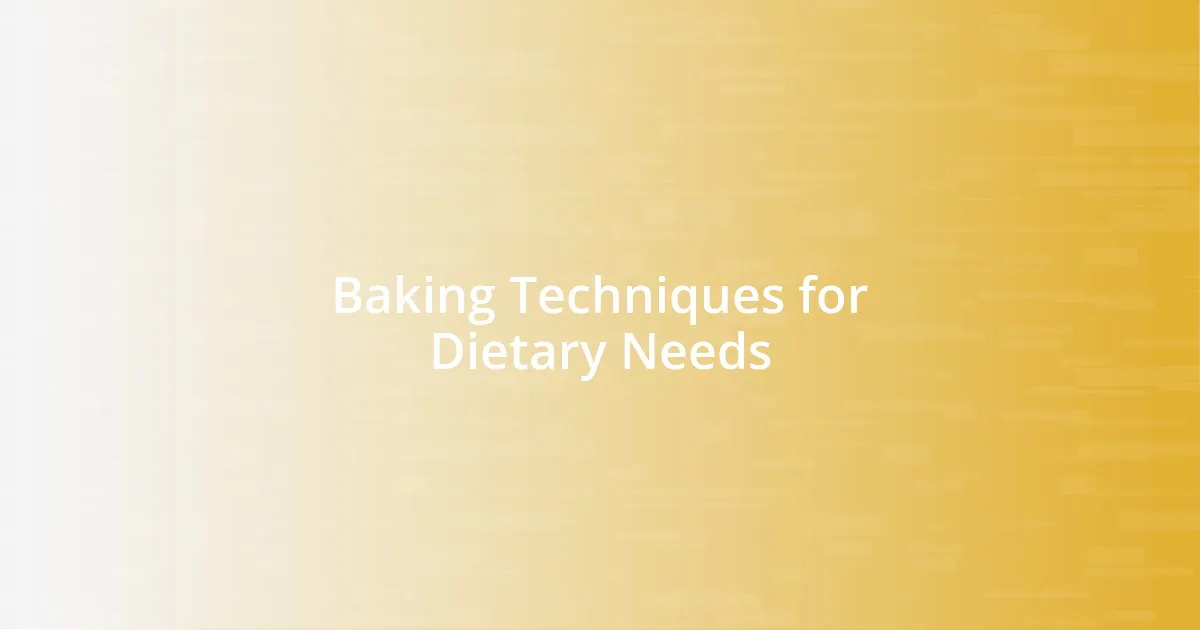
Baking Techniques for Dietary Needs
Baking techniques can vary significantly depending on dietary needs, and I’ve found a few methods that work wonders. For instance, when I began experimenting with egg replacements for vegan baking, I turned to flaxseed meal. Mixing ground flaxseed with water felt like science class, yet when I used it in brownies, the rich, fudgy texture blew me away. Can you imagine turning a classic favorite into something everyone can enjoy?
Another technique I embraced was adjusting baking times and temperatures. I once made a gluten-free bread that rose beautifully but ended up being slightly undercooked. I learned the hard way that gluten-free flours absorb moisture differently, requiring longer bake times. After that, I started checking for doneness with a toothpick about five minutes earlier than usual and then kept an eye on the bread. It’s a small change, but it made all the difference. Have you ever had a baking mishap that taught you something invaluable?
I also discovered the joy of incorporating moisture-rich ingredients, like applesauce or yogurt, in my recipes when reducing oil or dairy. I remember trying applesauce in a cake; the added flavor and moisture not only kept the cake tender but also introduced a delightful hint of sweetness. It turned a potentially dry disaster into a crowd-pleaser. Have you ever found that one ingredient that completely transformed your baking experience? Those moments of creativity are what keep me inspired in the kitchen!
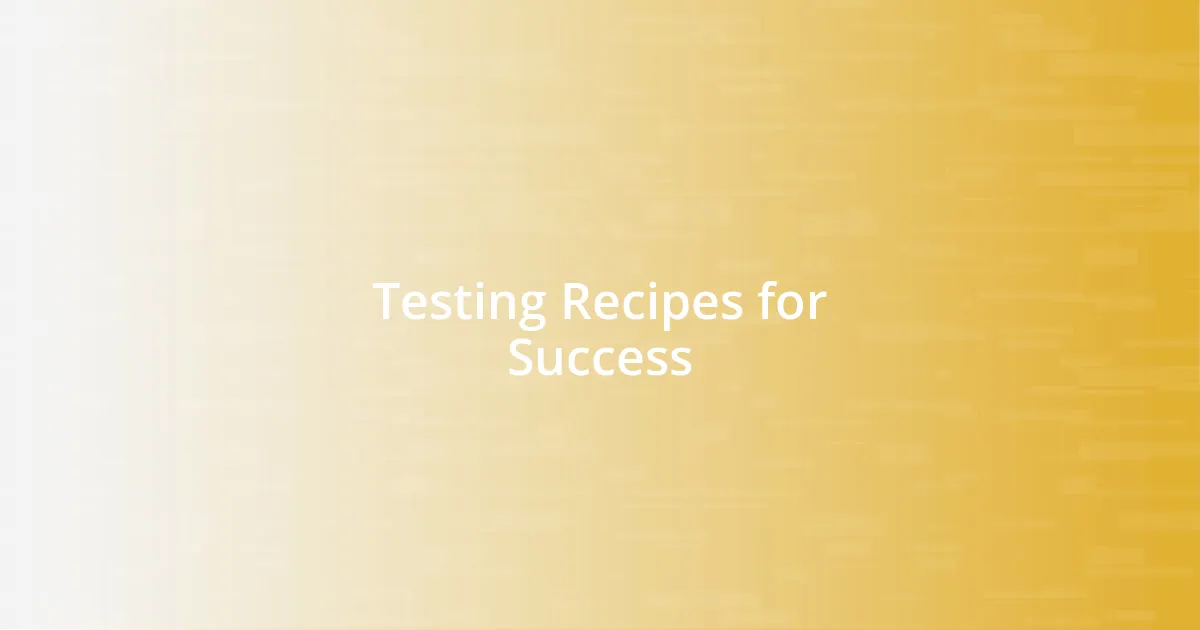
Testing Recipes for Success
Testing out new recipes is one of my favorite parts of baking, especially when dietary restrictions are in play. I once set out to create a chocolate chip cookie recipe suitable for my gluten-free friend. After several trials, I found a blend of almond and coconut flour that not only held up beautifully but also infused the cookies with a nutty flavor that was surprisingly delightful. Have you felt that rush of excitement when a recipe you’ve modified turns out not just acceptable, but extraordinary?
What I’ve learned is that each test is an opportunity to tweak and refine my approach. For instance, one time, I swapped out traditional milk for oat milk in a cake recipe without adjusting the other ingredients. The result? A beautiful cake that collapsed in the middle. That debacle taught me the significance of understanding how different dairy alternatives react in baking—something I now pay close attention to. Have you had those learning moments that shaped your technique in the kitchen?
I often keep a baking journal to document my experiments, allowing me to track textures, flavors, and the overall success of each recipe. This routine not only reminds me of what worked but also serves as a record for future baking endeavors. Saving those notes has become invaluable, especially when I tweak a recipe and think, “Was it one egg or two? What was the baking time?” It’s like having my own personal cookbook filled with lessons learned—what about you? Do you have any tools that help you navigate your baking journey?










